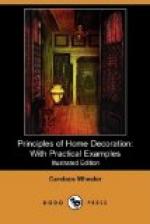In fact the mind which we cannot see may have a colour of its own, and it is natural that it should choose to dwell within its own influence.
We do not know why we like certain colours, but we do, and let that suffice, and let us live with them, as gratefully as we should for more explainable ministry.
If colours which we like have a soothing effect upon us, those which we do not like are, on the other hand, an unwelcome influence. If a woman says in her heart, I hate green, or red, or I dislike any one colour, and then is obliged to live in its neighbourhood, she will find herself dwelling with an enemy. We all know that there are colours of which a little is enjoyable when a mass would be unendurable. Predominant scarlet would be like close companionship with a brass band, but a note of scarlet is one of the most valuable of sensations. The gray compounded of black and white would be a wet blanket to all bubble of wit or spring of fancy, but the shadows of rose colour are gray, pink-tinted it is true; indeed the shadow of pink used to be known by the name of ashes of roses. I remember seeing once in Paris—that home of bad general decoration—a room in royal purples; purple velvet on walls, furniture, and hangings. One golden Rembrandt in the middle of a long wall, and a great expanse of ochre-coloured parquetted floor were all that saved it from the suggestion of a royal tomb. As it was, I left the apartment with a feeling of treading softly as when we pass through a door hung with crape. Vagaries of this kind are remediable when they occur in cravats, or bonnets, or gloves—but a room in the wrong colour! Saints and the angels preserve us!
[Illustration: SITTING-ROOM IN “WILD WOOD.” ONTEORA (BELONGING TO MISS LUISITA LELAND)]
The number, size, and placing of the windows will greatly affect the intensity of colour to be used. It must always be remembered that any interior is dark as compared with out-of-doors, and that in the lightest room there will be dark corners or spaces where the colour chosen as chief tint will seem much darker than it really is. A paper or textile chosen in a good light will look several shades darker when placed in large unbroken masses or spaces upon the wall, and a fully furnished room will generally be much darker when completed than might be expected in planning it. For this reason, in choosing a favourite tint, it is better on many accounts to choose it in as light a shade as one finds agreeable. It can be repeated in stronger tones in furniture or in small and unimportant furnishings of the room, but the wall tone should never be deeper than medium in strength, at the risk of having all the light absorbed by the colour, and of losing a sense of atmosphere in the room. There is another reason for this, which is that many colours are agreeable, even to their lovers, only in light tones. The moment they get below medium they become insistent, and make themselves of too much importance. In truth colour has qualities which are almost personal, and is well worth studying in all its peculiarities, because of its power to affect our happiness.




